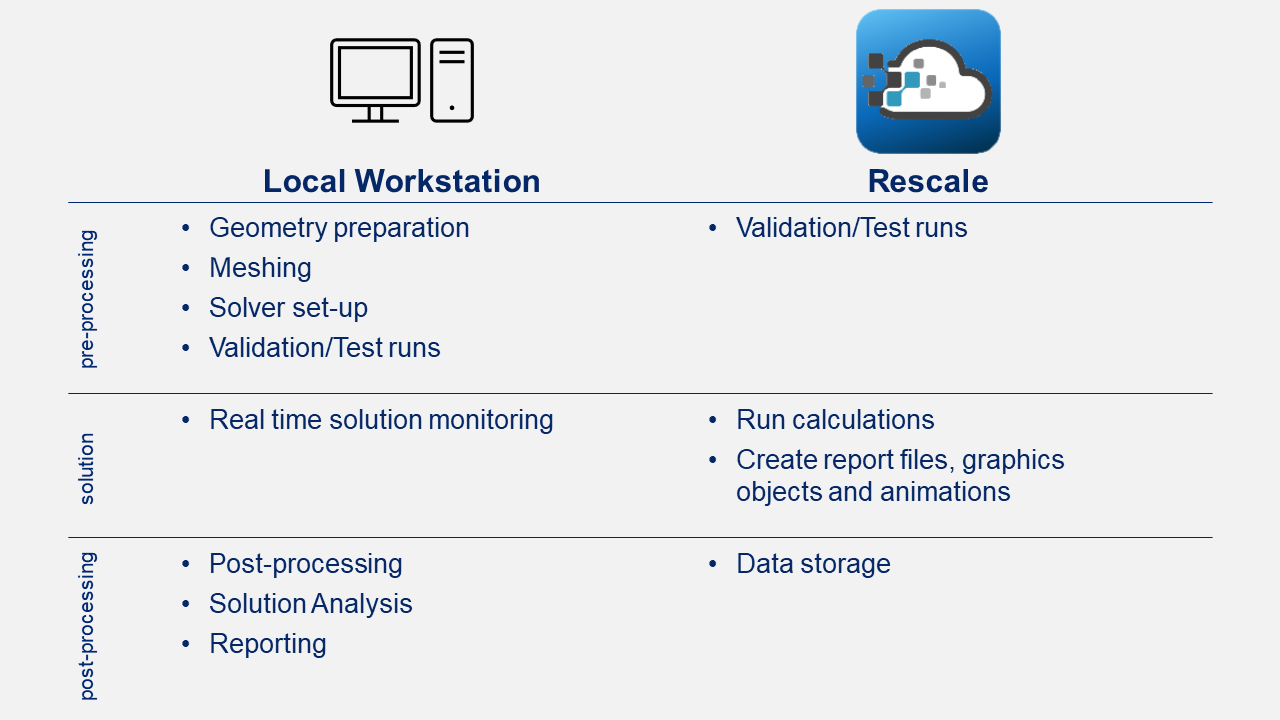Workflow and Hardware Recommendations
In today’s business world, staying competitive is crucial. Cloud computing is a flexible solution to boost efficiency. Cloud computing offers a wide range of benefits, but certain simulation tasks, like geometry preparation, mesh generation, result analysis, and post-processing, work better on dedicated user workstations. So, investing in powerful workstations for these tasks is recommended.

Fluent CloudConnect is most effective when the mesh and simulation setup originate from a local workstation. During this setup phase, preliminary test runs are often required. These can be conducted on either the local workstation or the Rescale platform. The user’s dedicated workstation should be powerful enough to manage less demanding simulations effectively. Alternatively, organizations may utilize their proprietary cluster infrastructure in conjunction with cloud computing resources for enhanced computational capabilities. Keep in mind that the computing requirements within the company may evolve over the lifespan of the hardware. Therefore EDRMedeso recommends to phase out all onsite high performance computing enviroments.
To figure out an optimal local workstation for your analysts, we suggest exploring options on the ANSYS Hardware partners’ websites.
Hardware requirements for workstations vary based on simulation complexity and usage. Here are considerations for pre- and post-processing in CFD simulations:
- Processor (CPU):
- The number of CPU cores significantly impact meshing speed when meshing in parallel with Fluent Meshing.
- When solving with ANSYS Fluent Solver, CPU core scaling is excellent. Additional cores typically decrease the solution time almost linearly.
- In actual usage, minimum of 8 cores is recommended and up to 20 cores in case the workstation is used for solving in addition to pre-processing.
- Latest generation AMD and Intel CPUs are recommended.
- Memory (RAM):
- Creating the mesh and running simulations will slow down significantly if there is not enough RAM
- A general guideline for a balanced and efficient simulation is to have about 4 GB of RAM for every 1 million cells. However, memory consumption vary between used methods.
- Advised RAM per core for Ansys Fluent is 8 GB. With larger core count system the number can be smaller.
- Opt for high-frequency RAM to optimize memory bandwidth and accelerate data transfer speed.
- Storage:
- CFD simulations generate large datasets that consume a lot of memory. Transient simulations for a large simulation models may consume hundreds of gigabytes of storage. Consider local storage size based on target simulations.
- Solid-state drives (SSDs) are recommended, but Ansys CFD applications are not overbearingly disk read/write intensive so hard-disk drives (HDDs) are acceptable.
- Other considerations:
- While it is important to have a GPU for post processing purposes, the GPU model itself has limited significance in hardware selection. Even if your solver benefits of GPU acceleration, it is better to do these in the Cloud as the availability to high end GPU accelerators onsite is very limited.
- Ensure your power supply unit (PSU) can handle the power demands of your hardware.
- A fast, reliable network connection is essential for seamless data transfer.